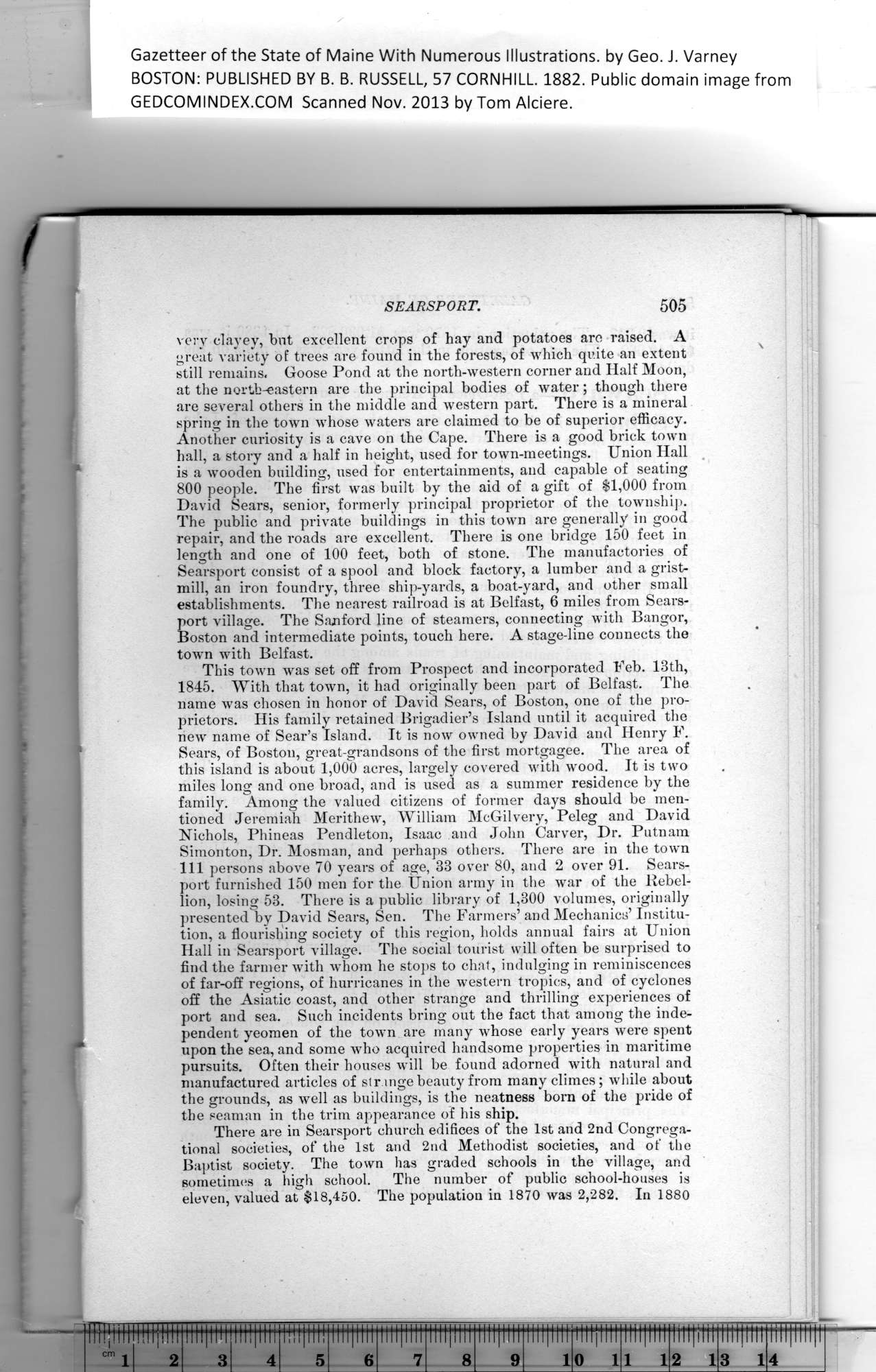|
Gazetteer of the State of Maine With Numerous Illustrations, by Geo. J. Varney
BOSTON: PUBLISHED BY B. B. RUSSELL, 57 CORNHILL. 1882. Public domain image from
SEARSPORT. 505
very clayey, hut excellent crops of hay and potatoes are raised. A
great variety of trees are found in the forests, of which quite an extent
still remains. Goose Pond at the north-western corner and Half Moon,
at the north-eastern are the principal bodies of water; though there
are several others in the middle and western part. There is a mineral
spring in the town whose waters are claimed to be of superior efficacy.
Another curiosity is a cave on the Cape. There is a good brick town
hall, a story and a half in height, used for town-meetings. Union Hall
is a wooden building, used for entertainments, and capable of seating
800 people. The first was built by the aid of a gift of $1,000 from
David Sears, senior, formerly principal proprietor of the township.
The public and private buildings in this town are generally in good
repair, and the roads are excellent. There is one bridge 150 feet in
length and one of 100 feet, both of stone. The manufactories of
Searsport consist of a spool and block factory, a lumber and a grist-
mill, an iron foundry, three ship-yards, a boat-yard, and other small
establishments. The nearest railroad is at Belfast, 6 miles from Sears-
port village. The Sanford line of steamers, connecting with Bangor,
Boston and intermediate points, touch here. A stage-line connects the
town with Belfast.
This town was set off from Prospect and incorporated Feb. 13th,
1845. With that town, it had originally been part of Belfast. The
name was chosen in honor of David Sears, of Boston, one of the pro-
prietors. His family retained Brigadier’s Island until it acquired the
new name of Sear’s Island. It is now owned by David and Henry F.
Sears, of Boston, great-grandsons of the first mortgagee. The area of
this island is about 1,000 acres, largely covered with wood. It is two
miles long and one broad, and is used as a summer residence by the
family. Among the valued citizens of former days should be men-
tioned Jeremiah Merithew, William McGilvery, Peleg and David
Nichols, Phineas Pendleton, Isaac and John Carver, Dr. Putnam
Simonton, Dr. Mosman, and perhaps others. There are in the town
111 persons above 70 years of age, 33 over 80, and 2 over 91. Sears-
port furnished 150 men for the Union army in the war of the Rebel-
lion, losing 53. There is a public library of 1,300 volumes, originally
presented by David Sears, Sen. The Farmers’ and Mechanics’ Institu-
tion, a flourishing society of this region, holds annual fairs at Union
Hall in Searsport village. The social tourist will often be surprised to
find the farmer with whom he stops to chat, indulging in reminiscences
of far-off regions, of hurricanes in the western tropics, and of cyclones
off the Asiatic coast, and other strange and thrilling experiences of
port and sea. Such incidents bring out the fact that among the inde-
pendent yeomen of the town are many whose early years were spent
upon the sea, and some who acquired handsome properties in maritime
pursuits. Often their houses will be found adorned with natural aud
manufactured articles of si nnge beauty from many climes; while about
the grounds, as well as buildings, is the neatness born of the pride of
tbe seaman in tbe trim appearance of his ship.
There are in Searsport church edifices of the 1st and 2nd Congrega-
tional societies, of the 1st and 2nd Methodist societies, and of the
Baptist society. The town has graded schools in the village, and
sometimes a high school. The number of public school-houses is
eleven, valued at $18,450. The population in 1870 was 2,282. In 1880
PREVIOUS PAGE ... NEXT PAGE
This page was written in HTML using a program written in Python 3.2
|
